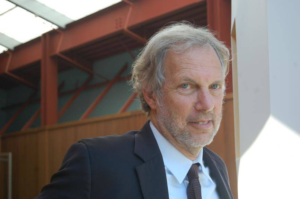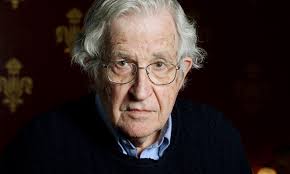Is Saving The Planet Under Capitalism Really Possible?
C.J. Polychroniou looks at the evidence and wonders if our leaders’ ever consider that capitalism is at the core of what’s causing life on Earth to vanish.
The theme of the 51st Anniversary of Earth Day is “Restore Our Earth.” To be sure, while there has been a growing level of environmental consciousness since the first Earth Day and environmental policies have changed dramatically over the last fifty years, we are really in a race to save the planet.
As things stand, the world now faces two existential crises that threaten organized human life as we know it, and life in general on planet Earth. The first one stems from the continued presence of nuclear weapons. The second one comes from global warming. However, while a nuclear war is actually preventable, we are not sure about global warming.
Allow me to elaborate.
The world has been faced with a threat from a nuclear war since the end of the Second World War. It is an intolerable threat to humanity, and it may just be the case that we have managed so far to avoid a nuclear holocaust by sheer accident. But a nuclear war can be prevented by addressing the sources of conflict and going beyond arms control. We can actually abolish nuclear weapons.
On the other hand, global warming is a certainty. It is already happening. According to the 2020 Global Climate Report from NOAA’s National Centers for Environmental Information, the global annual temperature has increased at an average rate of 0.08 degrees Celsius per decade since 1880, but the average rate of increase since 1981 (0.18 degrees Celsius) has been more than twice that rate.
Moreover, the effects of global warming are already present and include excessive heat waves, frequent wildfires, more droughts, greater frequency, intensity and duration of hurricanes, and higher sea levels which will have profound impact on low-lying coastal areas.
The effects of global warming will also be felt most severely on all categories of human movement: displacement, migration, and planned relocation. The data on human movement in the context of the climate emergency is already daunting. The Internal Displacement Monitoring Center (IDMC), which has been compiling data since 2008 on displacement due to natural disasters, estimated that between 2008 and 2019 there were 265 million new displacements associated with disasters such as storms, floods, and wildfires. This figure does not include estimates on displacement related to drought or estimates on migration and planned relocation associated with the climate emergency.
The impact of human migration due to the climate crisis is expected to be simply overwhelming. A report released by the World Bank in 2018 estimates that three regions of the world (Latin America, sub-Saharan Africa, and Southeast Asia) will produce 143 million more environmental migrants by 2050.
Make no mistake, global warming is the defining crisis of our time. Climate change has always happened on planet Earth, but there is overwhelming scientific evidence that the Earth’s globally averaged temperature surface temperature has been rising due to anthropogenic factors. According to the Intergovernmental Panel on Climate Change’s (IPCC) fifth assessment report, human emissions and activities have caused 100% of the observed increase in temperature since 1950.
The Global Economy In The Age Of The Pandemic And Beyond: An Interview With Political Economists Gerald Epstein And Robert Pollin
 The global economy experienced a massive contraction in 2020, with the overall global GDP falling by 4.3 percent. Compare that with the 2008 global financial crisis, which triggered a 1.8 drop in global output in 2009, and it’s bluntly clear why the Organization for Economic Cooperation and Development (OECD) called the global recession triggered by the pandemic “unprecedented in recent history.” Moreover, the World Bank sees a subdued recovery in 2021, while noting simultaneously that “if history is any guide, the global economy is heading for a decade of growth disappointments unless policy makers put in place comprehensive reforms.” In addition, there are stern warnings from major establishment institutions about the impact of climate change on financial and economic activity that makes one wonder what the future holds for global development and prosperity.
The global economy experienced a massive contraction in 2020, with the overall global GDP falling by 4.3 percent. Compare that with the 2008 global financial crisis, which triggered a 1.8 drop in global output in 2009, and it’s bluntly clear why the Organization for Economic Cooperation and Development (OECD) called the global recession triggered by the pandemic “unprecedented in recent history.” Moreover, the World Bank sees a subdued recovery in 2021, while noting simultaneously that “if history is any guide, the global economy is heading for a decade of growth disappointments unless policy makers put in place comprehensive reforms.” In addition, there are stern warnings from major establishment institutions about the impact of climate change on financial and economic activity that makes one wonder what the future holds for global development and prosperity.
With the above in mind, one needs to ask the following: Why did the ramifications of the CPVID-19 pandemic end up being so great and with far wider reaching effects than any other previous recession? Indeed, in what ways did the pandemic change the world? Moreover, did policymakers utilize all of the tools available to them to diminish the scope of the recession? And what should be done to ensure that economic recovery is steady and sustainable in the post-pandemic era?
In an interview below with C. J. Polychroniou, leading political economists Gerald Epstein and Robert Pollin shed considerable light on the above questions. Gerald Epstein is Professor of Economics and Co-Director of the Political Economy Institute at the University of Massachusetts at Amherst; Robert Pollin is Distinguished Professor of Economics and Co-Director of the Political Economy Institute at the University of Massachusetts at Amherst.
C. J. Polychroniou: The outbreak of the coronavirus pandemic caused a massive contraction of global economic activity. In what ways is the Covid-19 induced recession different from previous ones, including the 2008 global financial crisis, and how did it change the world?
Robert Pollin: If we consider the roughly 90-year period from the 1929 Wall Street collapse to the present, it is certainly the case that our current COVID-19-induced recession has been unique. To begin with, it is the only recession that was caused by a public health pandemic. Of course, previous recessions did also have triggering events—for example, the collapse of speculative financial bubbles both in 1929 and 2007 and the near-doubling of global oil prices both in 1973 and again in 1979. But these previous economic “shocks” were occurring within the operations of the economic system, not the public health system.
The public health shock in 2020 produced a cascade of other impacts that were also unique. One was that the speed and intensity of the economic downturn was unprecedented, even relative to the months immediately after the October 1929 Wall Street crash, which ushered in the 1930s Great Depression. Focusing for the moment on the United States, the number of people who lost their jobs and filed for unemployment insurance went from 256,000 in the week of March 14, 2020 to 2.9 million, the following week of March 21, an 11-fold increase. Two weeks later, in the week of April 4, the number of people filing for unemployment insurance spiked still higher, to 6.1million people. That was a 24-fold increase in the three-week period between mid-March and early April. Over the full year since the onset of the pandemic, 78 million people have applied to receive unemployment insurance. That is approximately half of the entire U.S. workforce. Moreover, these figures do not include the millions of people who lost their jobs but did not either qualify for unemployment insurance, or didn’t apply for whatever reason. It also doesn’t take account of the 8 million people who dropped out of the labor force within a matter of two months only, between February and April 2020. Remember that the U.S. experienced this magnitude of job losses over the year since the COVID outbreak despite the federal government mounting stimulus programs in March and December of 2020 amounting to about $3 trillion (14 percent of U.S. GDP) and the Federal Reserve bailing out Wall Street with another $3 trillion in bond purchases.
The European economies did not experience such severe spikes in unemployment. For the 27-country European Union, unemployment did rise, but only from 6.5 percent in February 2020 to a peak of 7.8 percent in September, before returning to 7.3 percent as of January 2021. This is despite the fact that the collapse in economic activity (as measured by GDP) was nearly as bad. Job losses weren’t as severe in Europe because several of the countries, including Germany, the UK, Ireland, and Denmark operated with work-sharing programs. With work sharing, workers are able to retain their jobs, while moving onto part-time schedules consistent with the decline in their employers’ revenue. For example, if the restaurant industry experienced a 36 percent decline in revenue, the businesses did not lay off 36 percent, or thereabouts, of its work force. It rather retained its workforce, but moved the workers onto roughly two-thirds time schedules. The employers then paid workers for two-thirds of their normal pay, while the government work-sharing program covered the remaining one-third. Congresswoman Pramila Jayapal, the head of the House Democratic Caucus, proposed such a program for the U.S., but her proposal went nowhere.
Latin America, sub-Saharan Africa, and India all experienced severe economic collapse during 2020. The expectation is that their recoveries will be slow and halting. This is first of all because, unlike the U.S. or Europe they don’t have the financial resources to mount major economic stimulus programs. They also haven’t been provided supplies of COVID vaccines at anywhere near the rate as the U.S. or even most of Europe. This is due to the pharmaceutical multinationals hoarding their vaccine patents rather than pushing out the vaccines as quickly as possible to all regions of the world, regardless of any country’s capacity to pay for them.
How long it will take to move the global economy onto a sustainable recovery path will depend, first of all, on how quickly inoculations become universal. Right now, it’s clear that protecting the profits of the pharma multinationals is taking priority over the health of the global population and an economic recovery.
C. J. Polychroniou: There is broad consensus that central banks can play a crucial role in supporting economic recovery. Did central banks respond to the Covid-19 pandemic as effectively as they could have? In other words, did they exhaust all of the available policy tools? And, if so, do they need new ones to combat the next economic downturn?
Gerald Epstein: The Covid-19 pandemic has had devastating impacts on the lives and livelihoods of millions of people around the globe. But for the wealthy, and for finance in particular, things have been mostly just fine.
The clearest picture of this contrast appears if one juxtaposes the global unemployment rate with the stock market we have experienced since the outbreak began in February 2020. As the pandemic took off in the Spring of 2020, global stock markets first crashed, and then, by the summer, started their gravity defying ascent. Meanwhile, the global deaths from the pandemic (or unemployment) have jumped and kept growing.
What accounts for this grotesque divergence? One key explanation is the massive financial intervention undertaken by the Federal Reserve (Fed), European Central Bank (ECB), Bank of England (BOE), and other central banks around the globe. When the pandemic first spread to Italy and then was announced by the World Health Organization (WHO) in February/March, panic gripped the global financial markets and these financial authorities immediately and massively stepped in. This enormous intervention led to a quick and remarkable recovery in global financial market activity and re-energized the “animal spirits” of stock market investors. But these interventions were much less favorable to workers, small businesses, and state and local/municipal governments, who were either more slowly helped by central government programs (in some countries) or not much at all (in others).
The intervention by the world’s major central banks was swift and powerful, much more so than with the Global Financial Crisis of 2007. In late January, 2020, word spread that the Covid-19 epidemic broke out into the open in Wuhan China, but it wasn’t until early February that it was clear that the virus was going to spread beyond China. On February 21, 2020, Italy announced a lockdown in the northern part of the country and then the global financial markets began to fall, and panic soon ensued. Immediately there was a flight to safety, with banks, hedge funds, stock market investors and others selling off their financial assets and buying “safe assets” notably US Treasury securities, German government securities (bunds) and the like. But when price movements and costs in these usually “safe” assets began to go haywire, financial institutions and wealthy investors began a desperate search for cash, in which they tried to liquidate these safe assets and bought the shortest term government assets and held cash assets in major banks. During this period, the corporate bond market experienced major distress as investors worried about the shut-down effects on corporate profits and cash flow, and the ratings agencies began downgrading these corporate securities. In the US, the municipal bond markets were also hit hard around the same time. In turn, the Fed, Bank of England (BOE) and the European Central Bank (ECB) massively intervened in financial markets, lowering interest rates close to zero, buying trillions of dollars of government bonds and other financial assets, and then creating special lending facilities to prevent bankruptcies, liquidity crises and asset fire sales in various financial markets around the world. In the Covid Panic, the Federal Reserve and other major central banks used many of the same tools during the Covid Crisis, as they had used to stabilize and bail-out the financial markets during the GFC, but they also created some new facilities to deal with problems in the financial markets.
A Green New Deal Is Actually More Affordable In the Long Term Than Fossil Fuels
With global warming representing humanity’s greatest existential crisis, reducing carbon dioxide and other greenhouse gas emissions to zero by 2050, as recommended by the 2018 report of Intergovernmental Panel on Climate Change (IPCC), should be one of the U.S.’s most urgent priorities. We need a Green New Deal now.
In examining the urgency of this necessity, we must recognize the current state of climate response in this country and around the world. Five years ago, the Paris Agreement on climate change was adopted. It was called “historic” because all members of the United Nations Framework Convention on Climate Change committed themselves to limiting global warming below 2 — and ideally to 1.5 — degrees Celsius (2°C) compared to pre-industrial levels. Yet progress toward that goal has been slow, where it has happened at all.
We are just emerging from the Trump era, when the former leader of the world’s largest economy and of the most powerful nation/empire in history not only questioned the science around climate change and withdrew the United States from the Paris Agreement, but also dismantled scores of environmental regulations and even reversed an Obama-rule on methane emissions — even though methane, the natural ingredient in natural gas, is 84 times more potent than carbon dioxide.
While some investors are shifting away from the fossil fuel economy, close to 85 percent of global primary energy still comes from coal, oil and gas. And no one should be led to believe that the temporary decline of greenhouse gas emissions during the COVID pandemic will last once the virus is brought under control.
As a matter of fact, while fossil fuel production needs to be decreased by roughly 6 percent between 2020 and 2030 in order for countries to remain in line with the 1.5°C target, governments are planning instead to increase fossil fuel production by an average of 2 percent annually, according to a report released by the Stockholm Environment Institute, together with the UN Environment Program and other leading research institutions.
In addition, between 2016 and 2020, the world’s largest banks have put collectively $3.8 trillion into fossil fuel companies, a development which may perhaps be the best indication of the toothless design behind the Paris climate accord and why it is naïve and dangerous to rely on the “invisible hand” of the market either for economic transformation or for a solution to the problem of climate change. Indeed, as climate economist Nicholas Stern put it more than a decade ago, greenhouse gas emissions “represent the biggest market failure the world has seen.”
Meanwhile, climate change denial remains prevalent, including among national leaders such as Jair Bolsonaro in Brazil and former President Trump.
The return of the U.S. to the Paris climate agreement, combined with Joe Biden’s executive order which explicitly recognizes that the United States and the world face “a profound climate crisis” and that tackling global warming will be a central objective in U.S. foreign policy and national security, are surely welcome news, but the efforts to combat global warming need to intensify. We need a well laid out plan for a swift transition away from fossil fuel and towards clean and renewable energy systems. As the World Meteorological Organization warned in a report issued back in March 2020, “time is fast running out.”
The Green New Deal is the best proposal we have to decarbonize the economy and protect the planet from the dire consequences of global warming, including hotter heat waves, increased tropical storms and floods, prolonged droughts, loss of freshwater, flooding of coastal areas, large-scale migration and potentially, eventually, human extinction.
The Green New Deal is portrayed as unaffordable, but in fact, it is financially manageable, especially given what is at stake if we fail to stop irreversible and disastrous changes to our climate system. According to leading economist Robert Pollin of the University of Massachusetts at Amherst, the global economy must spend an average of $4.5 trillion per year (or 2.5 percent of global GDP) between 2024-2050 in clean energy investments in order to hit the 2050 IPCC emissions reduction target. This estimate is corroborated by the latest study from the International Renewable Energy Agency, which puts the figure that needs to be invested for the energy transition at $4.4 trillion per year.
In addition to staving off the worst effects of global warming, the transition to a clean energy economy through the Green New Deal will also boost economic growth by creating millions of new, well-paying jobs in manufacturing, construction, energy, sustainable agriculture, engineering, and other sectors of the economy.
Pollin has shown in various published studies that the transition to clean energy systems will prove economically beneficial, expanding job opportunities across the economic spectrum. With respect to the United States, the employment opportunities that will be generated from the infrastructure programs designed to move the economy towards clean energy systems amount to millions of jobs.
Additionally, a transition to clean and zero-emission energy systems will substantially reduce energy costs and health care expenses. According to Mark Jacobson, one of the authors of a Green New Deal energy study published in the journal One Earth, the world will spend around $13 trillion per year on energy by 2050 if we are still reliant on fossil fuels, but the cost drops to $6.8 trillion if we are using clean, renewable energy. According to the same study, trillions of dollars will also be saved each year in health costs, because the Green New Deal would reduce toxic air and water pollution, which are now responsible for millions of deaths annually.
However, powerful economic interests and lack of political will stand in the way of a shift away from fossil fuels and toward a green economy. These two determinants are intertwined and must be addressed simultaneously if civilization is to continue to exist in any recognizable form.
The fossil fuel industry — which has been fully aware of the damage that its products cause to the environment but managed until fairly recently to hide this fact from the public — should be treated like a pariah and phased out. Banks and international financial institutions should be banned from funding fossil fuel production. “Environcide,” the deliberate destruction of the environment, should be recognized by international law as a crime against humanity, as Emmanuel Kreike has argued in his new book, Scorched Earth: Environmental Warfare as a Crime against Humanity and Nature. In addition, fossil fuel subsidies, which are estimated to run into hundreds of billions of dollars annually, must end.
In sum, all financial and political links to the fossil fuel industry must be severely disrupted if any serious progress is to be made toward building a green economy on a global scale.
The struggle to save the planet is the biggest challenge that has ever faced humanity, and time is running out. In this century, we will find out if our species is equipped to overcome its own narrow interests and work toward achieving a sustainable future not just for us, but for all life on planet Earth.
—
Copyright © Truthout. May not be reprinted without permission.
C.J. Polychroniou is a political economist/political scientist who has taught and worked in universities and research centers in Europe and the United States. His main research interests are in European economic integration, globalization, the political economy of the United States and the deconstruction of neoliberalism’s politico-economic project. He is a regular contributor to Truthout as well as a member of Truthout’s Public Intellectual Project. He has published several books and his articles have appeared in a variety of journals, magazines, newspapers and popular news websites. Many of his publications have been translated into several foreign languages, including Croatian, French, Greek, Italian, Portuguese, Spanish and Turkish. He is the author of Optimism Over Despair: Noam Chomsky On Capitalism, Empire, and Social Change, an anthology of interviews with Chomsky originally published at Truthoutand collected by Haymarket Books.
Alias Bob Dylan – Heimwee naar de verbeelding
 Het moet 1964 geweest zijn toen de mythe ontstond dat de jonge Robert Zimmerman, afkomstig uit Hibbing, Minnesota, als een soort eerbetoon aan de Ierse dichter Dylan Thomas, zijn naam had veranderd in Bob Dylan. Tot ver in de jaren zeventig dook het verhaal in allerlei artikelen en beschouwingen over Dylan op. In 1965 had Dylan al tegen een journalist van The Chicago Daily News gezegd: ‘I took the name Dylan because I have an uncle named Dillion. I changed the spelling but only because it looked better. I’ve read some of Dylan Thomas’s stuff, and it’s not the same as mine’.
Het moet 1964 geweest zijn toen de mythe ontstond dat de jonge Robert Zimmerman, afkomstig uit Hibbing, Minnesota, als een soort eerbetoon aan de Ierse dichter Dylan Thomas, zijn naam had veranderd in Bob Dylan. Tot ver in de jaren zeventig dook het verhaal in allerlei artikelen en beschouwingen over Dylan op. In 1965 had Dylan al tegen een journalist van The Chicago Daily News gezegd: ‘I took the name Dylan because I have an uncle named Dillion. I changed the spelling but only because it looked better. I’ve read some of Dylan Thomas’s stuff, and it’s not the same as mine’.
Robert Shelton, journalist bij The New York Times, begon in 1966 aan een biografie over Dylan (No Direction Home. Het boek zou pas in 1986 verschijnen). Verschillende malen liet Dylan aan Shelton weten: ‘Straigthen out in your book that I did not take my name from Dylan Thomas’.
Dylan was Shelton sowieso dankbaar, want in september 1961 had Shelton in de New York Times de eerste – lovende – recensie over een optreden van Dylan geschreven. Dylan was op dat moment slechts bekend bij een kleine kring van bezoekers van folkcafé’s in Greenwich Village. De recensie bracht hem onder de aandacht van Columbia Records en van producer John Hammond en bezorgde hem een platencontract.
 Interview
Interview
Inmiddels weten we dat veel van wat Dylan in interviews verklaarde met een flinke korrel zout genomen moet worden. Met biografische gegevens is hij altijd uiterst karig geweest en verschillende verhalen die hij over zijn jeugd en puberjaren vertelde, bleken achteraf geheel verzonnen. Legendarisch is een van zijn eerste radio-interviews. Nog voor de release van zijn eerste plaat interviewde presentatrice Cynthia Gooding hem in maart 1962 een uur lang voor WBAI-FM Radio, New York. Onduidelijk is of het programma ooit is uitgezonden maar het is gelukkig wel bewaard gebleven. [1] Zo vertelt hij Gooding dat hij op jeugdige leeftijd wegliep van huis en enkele jaren met een circus door de Verenigde Staten was getrokken. In New Orleans zou hij op 12-jarige leeftijd kennis gemaakt hebben met oude bluesmuzikanten die hem het mondharmonicaspelen hadden geleerd. Niets van waar: het bleken gefingeerde biografische verhalen. Soortgelijke ‘herinneringen’ zou hij in zijn beginjaren nog wel vaker verkondigen. Read more
Noam Chomsky: Biden’s Foreign Policy Is Largely Indistinguishable From Trump’s
President Joe Biden’s domestic policies, especially on the economic front, are quite encouraging, offering plenty of hope for a better future. The same, however, cannot be said about the administration’s foreign policy agenda, as Noam Chomsky’s penetrating insights and astute analysis reveal in this exclusive interview for Truthout. Chomsky is a world-famous public intellectual, Institute Professor Emeritus at MIT and Laureate Professor of Linguistics at the University of Arizona.
C.J. Polychroniou: Noam, two months after being in the White House, Biden’s foreign policy agenda is beginning to take shape. What are the signs so far of how the Biden administration intends to address the challenges to U.S. hegemony posed by its primary geopolitical rivals, namely Russia and China?
Noam Chomsky: The challenge to U.S. hegemony posed by Russia and particularly China has been a major theme of foreign policy discourse for some time, with persistent agreement on the severity of the threat.
The matter is plainly complex. It’s a good rule of thumb to cast a skeptical eye when there is general agreement on some complex issue. This is no exception.
What we generally find, I think, is that Russia and China sometimes deter U.S. actions to enforce its global hegemony in regions on their periphery that are of particular concern to them. One can ask whether they are justified in seeking to limit overwhelming U.S. power in this way, but that is a long distance from the way the challenge is commonly understood: as an effort to displace the U.S. global role in sustaining a liberal rule-based international order by new centers of hegemonic power.
Do Russia and China actually challenge U.S. hegemony in the ways commonly understood?
Russia is not a major actor in the world scene, apart from the military force that is a (very dangerous) residue of its earlier status as a second superpower. It does not begin to compare with the U.S. in outreach and influence.
China has undergone spectacular economic growth, but it is still far from approaching U.S. power in just about any dimension. It remains a relatively poor country, ranked 85th in the UN Human Development Index, between Brazil and Ecuador. The U.S., while not ranked near the top because of its poor social welfare record, is far above China. In military strength and global outreach (bases, forces in active combat), there is no comparison. U.S.-based multinationals have about half of world wealth and are first (sometimes second) in just about every category. China is far behind. China also faces serious internal problems (ecological, demographic, political). The U.S., in contrast, has internal and security advantages unmatched anywhere.
Take sanctions, a major instrument of world power for one country on Earth: the U.S. They are, furthermore, third-party sanctions. Disobey them, and you’re out of luck. You can be tossed out of the world financial system, or worse. It’s pretty much the same wherever we look.
If we look at history, we find regular echoes of Sen. Arthur Vandenberg’s 1947 advice to the president that he should “scare hell out of the American people” if he wanted to whip them up to a frenzy of fear over the Russian threat to take over the world. It would be necessary to be “clearer than truth,” as explained by Dean Acheson, one of the creators of the postwar order. He was referring to NSC-68 of 1950, a founding document of the Cold War, declassified decades later. Its rhetoric continues to resound in one or another form, again today about China.
NSC-68 called for a huge military build-up and imposition of discipline on our dangerously free society so that we can defend ourselves from the “slave state” with its “implacable purpose… to eliminate the challenge of freedom” everywhere, establishing “total power over all men [and] absolute authority over the rest of the world.” And so on, in an impressive flow.
China does confront U.S. power — in the South China Sea, not the Atlantic or Pacific. There is an economic challenge as well. In some areas, China is a world leader, notably renewable energy, where it is far ahead of other countries in both scale and quality. It is also the world’s manufacturing base, though profits go mostly elsewhere, to managers like Taiwan’s Foxconn or investors in Apple, which is increasingly reliant on intellectual property rights — the exorbitant patent rights that are a core part of the highly protectionist “free trade” agreements.
China’s global influence is surely expanding in investment, commerce, takeover of facilities (such as management of Israel’s major port). That influence is likely to expand if it moves forward with provision of vaccines virtually at cost in comparison with the West’s hoarding of vaccines and its impeding of distribution of a “People’s Vaccine” so as to protect corporate patents and profits. China is also advancing substantially in high technology, much to the consternation of the U.S., which is seeking to impede its development.
It is rather odd to regard all of this as a challenge to U.S. hegemony.
Bloed, zweet en tranen of: Churchill, Cash en Hazes
Eén keer trek je de conclusie
Vriendschap is een illusie
Vriendschap is een droom
Een pakketje schroot met een dun laagje chroom
’t Is moeilijk bescheiden te blijven
Wanneer je zo goed bent als ik
Zo stoer, zo charmant en zo aardig
Dat zie je in één ogenblik
En ik ben blij dat ik je niet vergeten ben
Dat ik nog zo veel kleine dingen van je ken
Omdat ik steeds ben blijven dromen
dat het toch zo ver zou komen
Ben ik blij dat ik je niet vergeten ben
Met bloed, zweet en tranen
Zei ik, rot hier nu maar op
Met bloed, zweet en tranen
Zei ik vrienden, dag vrienden, de koek is op
Wat is er bevrijdender – althans, vanuit therapeutisch oogpunt bezien – dan voluit meeblèren met een vol Ahoy of Goffert? Of een bomvolle Johan Cruyff Arena, sinds de Ajax-aanhang zich de André Hazes-hit Bloed, zweet en tranen heeft toegeëigend?
Dat begrip – bloed, zweet en tranen – wordt buiten onze landsgrenzen – en wellicht ook daarbinnen – waarschijnlijk op de eerste plaats geassocieerd met Blood, Sweat & Tears of, zoals het vaker werd weergegeven, BS&T, de New Yorkse jazzrockband die tussen maart 1969 en oktober 1970 megahits had met You’ve made me so very happy, Spinning wheel, And when I die en Hi-De-Ho.
De oorsprong voor de naam van de band wordt gewoonlijk toegeschreven aan de speech die Winston Churchill hield in het Lagerhuis op 13 mei 1940, bij het begin van zijn eerste periode als minister-president.
Voluit klinkt de passage als volgt: “I would say to the House, as I said to those who have joined this Government: I have nothing to offer but blood, toil, tears and sweat.”
Churchill mag dan wel in 1953 de Nobelprijs voor literatuur gewonnen hebben – een belangrijk deel van zijn werkzame leven verdiende hij meer met schrijven en als veelgevraagd spreker dan als politicus – , voor de woorden die hij wereldberoemd zou maken, moest hij toch putten uit de Engelse letteren.
De poëet en avonturier Lord Byron (1788-1824) schreef in zijn meer dan 100 pagina’s tellende gedicht The Age of Bronze, dat in 1823 verscheen
Year after year they voted cent per cent,
Blood, sweat, and tear-wrung millions – why? for rent!
En nog verder terug in de Britse literatuurgeschiedenis vindt men de dominee-dichter John Donne (1572-1631), die in zijn gedicht An Anatomy of the World (1611) schrijft:
That ’tis in vain to dew, or mollifie it with thy tears, or sweat, or blood
(to dew = bevochtigen, to mollify = verzachten).
De enumeratie ‘bloed, zweet en tranen’ moet, in welke volgorde dan ook, dus al heel lang niet alleen bestaan hebben, maar ook als literaire eenheid gebruikt zijn.
Het is intussen maar zeer de vraag of die beroemde woorden van Churchill BS&T geïnspireerd hebben bij de keuze van een naam. Om te beginnen worden ze niet exact geciteerd. Sterker nog, uit de oorspronkelijke tekst is een vierde woord – toil, gezwoeg – weggelaten en staan sweat en tears in de omgekeerde volgorde.
Ten tweede heeft Al Kooper, een van de oprichters van BS&T, zich uitgelaten over de herkomst van hun naam. In zijn autobiografie met de weinig van aangename herinneringen getuigende titel Backstage Passes and Backstabbing Bastards (1998), herinnert hij zich: ‘One particular night, Jimi Hendrix, B. B. King, myself, and an unidentified drummer and bass player were going at it all night at the Cafe Au Go Go. At daybreak, when we finished playing, they put the house lights on and somebody observed: ‘Christ! Look at the organ! There’s blood all over the keyboard!’ Sure enough, I had cut my hand playing, and in the state of bliss induced by my compatriot’s sound had not felt a thing. What a great album cover, I thought. No. What a great name for a band.’
Geen uitleg die meteen overtuigt, al was het maar omdat al dat bloed wel verklaard wordt maar de herkomst van de tranen en het zweet onbekend blijft. Dan geloven wij eerder, dat de naam van de band geïnspireerd is door de country-zanger Johnny Cash, die immers in 1963 een album uitbracht met de titel Blood, sweat and tears. (Dat laat natuurlijk de vraag onverlet waar Cash het vandaan heeft.)
Blood, toil, tears and sweat is trouwens niet het enige spoor dat Churchill in de popmuziek heeft achtergelaten. Om overigens volstrekt onduidelijke redenen koos een Amerikaanse band als naam The Beginning of the End. Hun enig bekende wapenfeit is het album Funky Nassau (1971), interessanter is de bron van hun naam.
Uit weer een andere toespraak van Churchill, in november 1942, ging dit citaat een eigen leven leiden: “This is not the end. It is not even the beginning of the end. But it is, perhaps, the end of the beginning.”
Het was een verwijzing naar de aanval van Field Marshal Bernard Montgomery – koosnaam Monty – op de Duitse troepen onder aanvoering van generaal-veldmaarschalk Erwin Rommel – bijnaam de Woestijnvos – in Noord-Afrika.
Het was al met al dan ook niet te vermijden, dat blood, sweat and tears enkele minder creatieve geesten zou verleiden tot speels bedoelde titels van hun memoires. Zo herleefde Steve Katz, mede-oprichter van BS&T, zijn wildste jaren in het boek Blood, sweat, and My Rock ‘n’ Roll years (2015).
Nog makkelijker maakten de drie makers van een boek over Rocker33, een van de spraakmakendste nachtclubs in Duitsland, zich van de titel af. Zij kwamen eendrachtelijk op Love, sweat and tears (2020).
Succes verzekerd!






